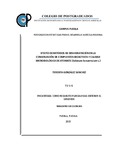| dc.description.abstract | La ingesta del jitomate en la dieta diaria se asocia fuertemente con la reducción del riesgo de enfermedades crónicas, por lo que actualmente tiene importancia por su valor biológico y actividad antioxidante. La preservación y potenciación de esos compuestos permiten desarrollar diferentes formas de conservación como es la deshidratación, teniendo en cuenta mantener los atributos físico-químicos y los compuestos bioactivosdel fruto. El presente trabajo tuvo como objetivo analizar el efecto de la deshidratación solar (DS), liofilización (LIOF) y tecnología de descomprensión instantánea controlada (DIC) sobre el color, compuestos nutricionales, compuestos bioactivos, actividad antioxidantey características microbiológicas del jitomate deshidratado. Se utilizó jitomate tipo Saladette variedad Rafaello, cultivado en el municipio de Tetela de Ocampo, Puebla. Para el análisis microbiológico, los frutos se prepararon según la Norma Oficial Mexicana en relación a coliformes totales, bacterias mesófilas aerobias, hongos y levaduras. Para el análisis de compuestos nutricionales y bioactivos, los frutos lavados y desinfectados se sometieron a los tres procesos de deshidratación. En cada tratamiento se determinó color, azucares solubles totales (AST), minerales, vitamina C, licopeno, compuestos fenólicos totales (CFT), actividad antioxidante y la calidad microbiológica. Los resultados mostraron que la DS conservo mejor el color, el licopeno y la vitamina C; el procesamiento DIC preservo mejor los AST, minerales (P, K, Ca y Fe), CFT, y la capacidad antioxidante (CI50);la liofilización no mostró ventaja en conservar el color y los componentes bioactivos, pero si el Fe. El análisis microbiológico de los frutos deshidratados tuvo valores dentro de los permitidos por las Normas Oficiales Mexicanas para bacterias, hongos y levaduras. El análisis por componentes principales con base en la presión y seis variables analizadas explicó 97 % de la variación entre los tratamientos, con los tres primeros componentes principales se distinguen tres grupos: Grupo I (DIC, 4 bar), Grupo II (DIC, 1.4, 2.5 y 3.6) y Grupo III (DS, 1 bar y LIOF, 0.26 bar). Los frutos procesados por tecnología DIC, de acuerdo al modelo de regresión empírico determinó las condiciones de operación óptima para maximizar la respuesta de AST en 4.05 bar y 9.44 s, licopeno en 4 bar y 24.6 s, de los CFTen 4.05 bar y 40.55 s, de la actividad antioxidante en 2.78 bar y 40.55 s, y de la CI50 en 0.94 bar y 28.25 s. Se concluye que la deshidratación de jitomate puede realizarse sin perder considerablemente el color, los compuestos nutricionales y compuestos bioactivos, mediante una estrategia de deshidratado que combine algunos métodos, como la deshidratación solar, e inclusive como pre-tratamiento aunado al DIC, con los que se puede reducir la pérdida de propiedades organolépticas y de los compuestos bioactivos característicos del jitomate fresco. _______________ EFFECT OF DRYING METHODS ON THE CONSERVATION OF BIOACTIVE COMPOUNDS AND MICROBIOLOGICAL QUALITY OF TOMATO (Solanum lycopersicum L.). ABSTRACT: The intake of tomatoes in the diet is strongly associated with the reduced risk of chronic diseases, which currently has importance for their biological value and antioxidant activity. The preservation and enhancement of these compounds allow developing different forms of conservation such as drying, considering maintaining the physicochemical attributes and bioactive compounds of the fruit. This study aimed to analyze the effect of solar dehydration (SD), lyophilization (LIOF) and instant controlled pressure (DIC) technology on color, nutritional compounds, bioactive compounds, antioxidant activity and microbiological characteristics of dried tomato. Saladette tomato of Rafaello variety, grown in fertirigation in the municipality of Tetela de Ocampo, Puebla was used. For microbiological analysis, the fruits were prepared in accordance to the Official Mexican Norms in relation to total coliforms, mesophilic aerobic bacteria, fungi and yeasts. For analysis of nutritional and bioactive compounds, the fruits washed and disinfectedwere subjected to the three drying processes. In each treatment the color, total soluble sugars (TSA), minerals, vitamin C, lycopene, total phenolic compounds (TFC), antioxidant activity and microbiological quality were determined. The results showed that the DS better preserved color, lycopene and vitamin C; DIC technology best preserved the TSAas well as mineral (P, K, Ca and Fe), CFT, and antioxidant capacity (IC50); lyophilization showed no advantage in preserving the color and bioactive components, but retained Fe.The microbiological analysis of dried fruits had values within allowed by Mexican Official Norms for bacteria, fungi and yeasts. The principal component analysis based on pressure andsix variables explained 97% of the variation between treatments, with the first three principal components, three groups were distinguished: Group I (DIC, 4 bar), Group II (DIC, 1.4, 2.5 and 3.6 bar) and Group III (DS, 1 bar and LIOF, 0.26 bar).The fruits processed by DIC technology, according to the model of empirical regression determined the conditions of optimal operation to maximize the response of TSA in 4.05 bar and 9.44 s, lycopene 4 bar and 24.6 s, the CFT in 4.05 bar and 40.55 s, antioxidant activity in 2.78 bar and 40.55 s, and CI50 0.94 bar and 28.25 s.It is concluded that dehydration of tomato can be accomplished without color, nutritional compounds and bioactive compounds are greatly lost; through a strategy that combines some methods such as solar dehydration, and even as a pretreatment coupled with DIC, with which they can reduce the loss of organoleptic properties and characteristic of fresh tomato bioactive compounds. | es_MX |


